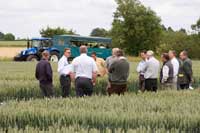Merger will benefit growers, says NIAB Group’s chief

One was established thirty years ago by a dozen like-minded cereal growers to generate local agronomy advice.
The other was started in 1919 to help tackle food shortages after the end of the First World War.
Both are independent, have charitable status, operate subscription-based membership schemes and are respected for their scientific and agronomic expertise.
Last week, after months of talks, NIAB and TAG joined forces to become the NIAB Group.
With its headquarters in Cambridge, a turnover of £12million and around 200 staff, the new organisation has grand plans but still has a great deal of detail to finalise.
“Our aim is to work with the whole industry to become the UK’s leading crop research centre,” says chief executive Tina Barsby, who will be heading up the NIAB Group.
“That includes growers, agronomists, distributors, manufacturers, researchers and scientists. There is representation of the entire spectrum in our joint offering.”
Independence
Maintaining the new organisation’s independence is of the utmost importance and will be a key part of its identity, she adds. “Science is independent. Keeping that status is essential to our integrity, although there will be times when it won’t necessarily make us popular.”
Despite the similarities between NIAB and TAG, Dr Barsby doesn’t believe there is too much overlap in their output. “We’ve been talking to our members and they are telling us that they get value from both organisations. That’s why, up until now, they’ve been prepared to sign up to both.”
Membership will remain separate this year, although the plan is for one subscription and trials operation starting around mid-2010.
Other changes are also inevitable, she admits. “A good example is the TAG Research Bulletin and NIAB’s Landmark publication – whether we need both is debatable.”
But she stresses TAG farmer members, many of whom are about to renew their subscriptions, won’t receive any less for their money.
“We will be adding value to existing products and bringing in new ones. We are also going to retain the TAG identity for the foreseeable future.”
TAG’s practice of having farmer technical committees deciding on research direction will remain, she confirms.
“We’re going to enhance this regional activity by forming an agronomy strategy group at a higher level, to which the former TAG board members have been invited to join. The regional committees will feed into this, so there’s a broader look at agronomic challenges.”
Better trained staff
Growers will see a number of benefits, from the presence of better trained staff at regional meetings to the generation of new research ideas and a greater breadth of collaborative projects.
“The new strain of yellow rust that’s been identified this year is a good way of illustrating how things will work,” she explains.
“At NIAB, we’ve been collaborating with the John Innes Centre on genetic research, while also investigating the pathology and ways of introducing varietal resistance.
“At TAG, work has focused on giving growers solutions to yellow rust control, from variety choice to spray programmes.
“Bringing these efforts together will allow a longer-term view of the problem, so that we can bring practical solutions to the industry.”
Geoff Elliot, the outgoing chairman of TAG, who is joining the NIAB Group board, is excited about the new arrangements and believes that growers will be better served by the merger.
“It means we’ll have a unique source of research expertise and technical services. The group will be able to attract additional sources of funding, bid for broader research contracts and invest in the future with confidence.”

